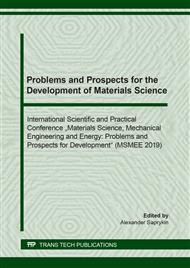p.1
p.7
p.14
p.20
p.26
p.32
p.37
p.43
Use of Homogenizing Annealing for Formation of the Structure and Properties of Cast Blanks Produced from the Alloys Obtained by Aluminothermy
Abstract:
This paperwork presents the results of a series of experiments on the use of homogenizing annealing, aimed at the possibility to control the structure and properties of steel samples obtained by aluminothermy. This method of processing, in some cases, allows to eliminate the need to use subsequent heat treatment operations due to the achievement of the required properties by the cast blank material. Refractory materials and thermite mixtures used, conditions for the production of castings and their total chemical composition are given. The tensile diagram analysis of the samples before and after heat treatment is presented; the structures and diffraction patterns of the samples’ destruction spots are considered. The material obtained by aluminothermy corresponds in its chemical composition to A1, A2, A3, A4 grade of steels for the rail transport according to GOST 31334-2007 which are used in the manufacture of locomotive axes and other rolling stock.
Info:
Periodical:
Pages:
20-25
Citation:
Online since:
April 2020
Authors:
Price:
Сopyright:
© 2020 Trans Tech Publications Ltd. All Rights Reserved
Share:
Citation:


